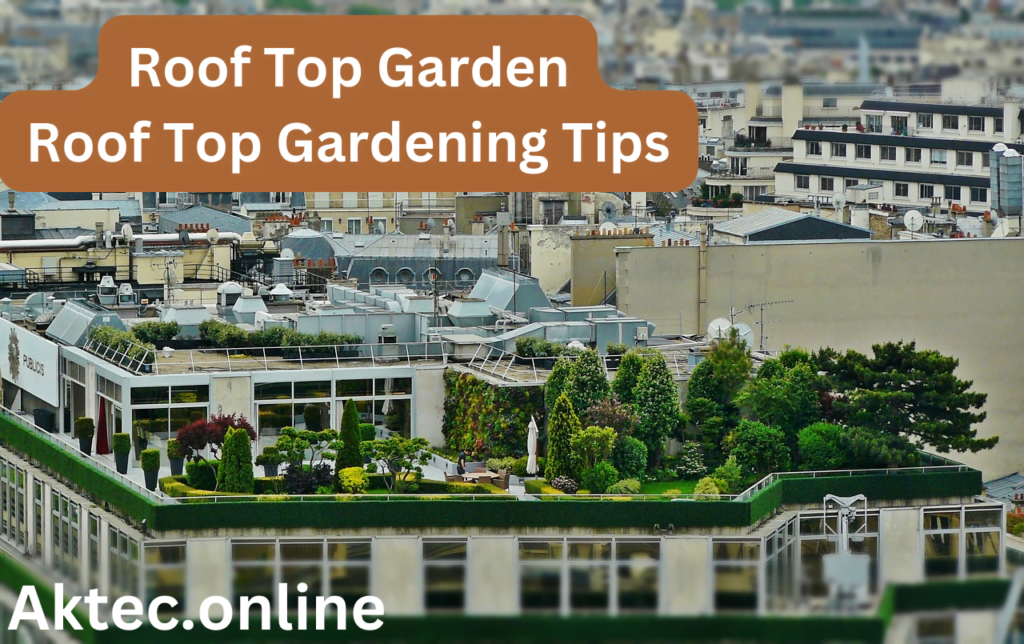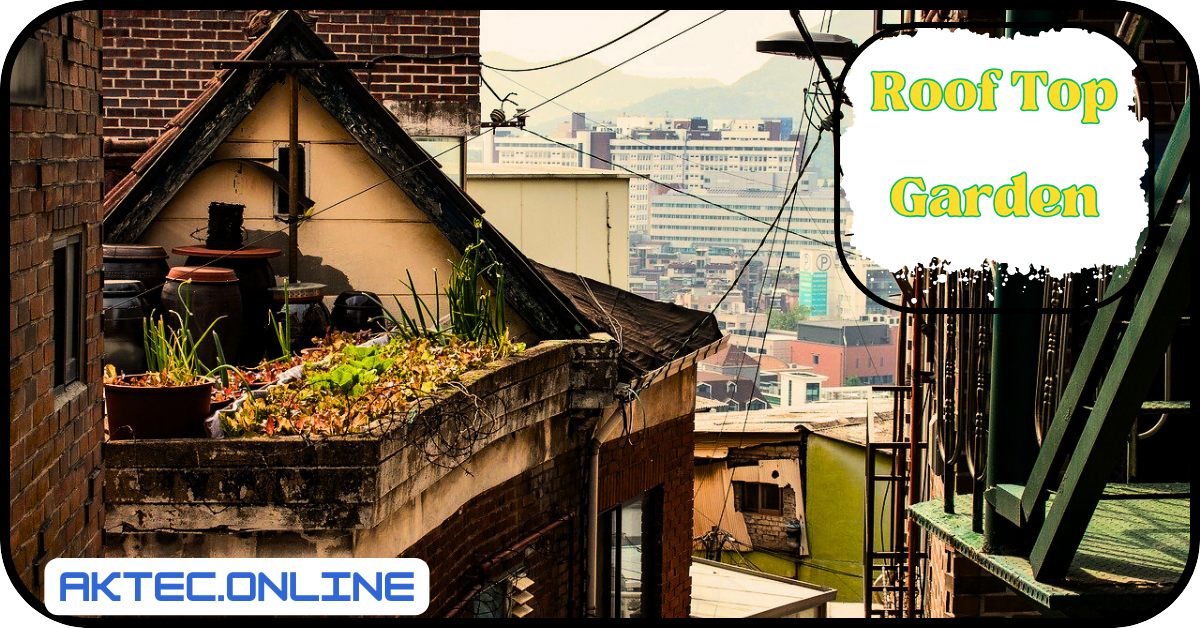
Roof Top Garden is a verdant sanctuary established on the rooftop of a building. These urban paradises not only enhance the aesthetics of your space but also boast a multitude of environmental and personal benefits.
In recent years, roof top gardens have skyrocketed in popularity, transforming concrete jungles into vibrant ecosystems teeming with life
Why Create a Roof top Garden?
The advantages of roof top garden are manifold. They provide a tranquil escape in the heart of the city, offering a space to unwind, entertain guests, and reconnect with the natural world. Furthermore, roof top gardens contribute significantly to a building’s sustainability. They act as natural air filters, improving air quality by absorbing pollutants and releasing oxygen.
This translates to a healthier urban environment, mitigating the urban heat island effect – a phenomenon where cities experience higher temperatures compared to surrounding rural areas. Studies have also shown that roof top gardens can enhance mental and physical well-being by reducing stress, promoting feelings of calm, and even improving cognitive function.
Planning and Designing Your Rooftop Paradise: A Step-by-Step Guide
Before embarking on your roof top garden adventure, a crucial first step is to assess the structural capacity of your roof. Ensure your roof can handle the additional weight of soil, plants, containers, and irrigation systems. Consulting a structural engineer for a professional evaluation is highly recommended. This will provide peace of mind and prevent potential structural issues down the line.
Next comes the exciting part: choosing the right plants and containers.
water is ideal, especially in regions with limited rainfall. Consider factors like sunlight exposure, wind tolerance, and mature plant size when making your selections.
Container Selection: Opt for lightweight containers like plastic, fabric pots, or recycled materials to minimize weight load on your roof. For larger plants, opt for containers with built-in wheels for easy maneuvering. Drainage holes are essential to prevent water logging and potential roof damage. Explore creative container options like recycled barrels, old bathtubs, or repurposed furniture to add a unique touch to your rooftop oasis.
water is ideal, especially in regions with limited rainfall. Consider factors like sunlight exposure, wind tolerance, and mature plant size when making your selections.
Container Selection: Opt for lightweight containers like plastic, fabric pots, or recycled materials to minimize weight load on your roof. For larger plants, opt for containers with built-in wheels for easy maneuvering. Drainage holes are essential to prevent water logging and potential roof damage. Explore creative container options like recycled barrels, old bathtubs, or repurposed furniture to add a unique touch to your rooftop oasis.
Irrigation and drainage are essential elements for a flourishing roof top garden.
Irrigation and drainage are essential elements for a flourishing roof top garden.
Irrigation: An automated drip irrigation system can deliver water efficiently directly to the root zone of your plants, minimizing water waste. Timer controls can be set to ensure plants receive the appropriate amount of water based on their needs and the prevailing climate.
Drainage: A proper drainage system prevents waterlogging, which can damage your roof and harm plants. Consider incorporating a lightweight drainage mat beneath your containers or installing a raised garden bed with a built-in drainage layer.
Maintaining Your Rooftop Sanctuary: Tips for a Thriving Garden
Regular watering and fertilizing are vital for keeping your roof top garden healthy. The frequency will depend on your chosen plants, climate, and container size. For example, drought-tolerant succulents will require less frequent watering compared to vegetable gardens. Opt for organic, slow-release fertilizers to nourish your plants without polluting the environment.
Regular pruning promotes plant growth, prevents overcrowding, and encourages bushier, healthier plants. Deadheading, the removal of spent flowers, also encourages continued blooming in some varieties.
Be mindful of potential pests and diseases. Implement organic pest control methods whenever possible, such as using insecticidal soap or introducing beneficial insects like ladybugs that prey on harmful ones. Early detection and intervention are key to preventing pest outbreaks.
Seasonal considerations are crucial for a thriving roof top garden. Adjust watering schedules based on changing weather patterns. In harsh winters, provide frost protection for sensitive plants by covering them with frost cloth or burlap. Group plants with similar water needs together to simplify watering routines.
Studies have consistently highlighted the mental and physical health benefits associated with roof top gardens. Exposure to nature reduces stress, promotes relaxation, and even improves cognitive function. The act of tending to your roof top garden offers a sense of accomplishment, fosters a connection with nature, and provides a space for mindfulness and meditation, enhancing overall well-being.
Why Go Green Up Top? Unveiling the Advantages of Rooftop Gardens

Rooftop gardens provide a unique opportunity to cultivate a piece of nature in the heart of the city. Here are just a few reasons why they’re gaining popularity in Pakistan:
Increased Green Space: Roo ftop gardens contribute significantly to the limited green spaces within urban areas. They provide habitats for pollinators, improve air quality, and offer a cooling effect during Pakistan’s hot summers.
Fresh, Homegrown Produce: Imagine harvesting crisp lettuce or juicy tomatoes grown right on your rooftop! Roo ftop gardens allow you to cultivate fresh, local food, reducing reliance on grocery stores and promoting a more sustainable lifestyle.
Enhanced Aesthetics & Relaxation: Transform your rooftop into a tranquil escape. Lush greenery and vibrant flowers create a serene environment for relaxation and stress reduction, offering a welcome respite from the hustle and bustle of city life.
Planning Your Rooftop Paradise: A Step-by-Step Guide
Before diving into planting, a little planning goes a long way in ensuring the success of your rooftop garden in Pakistan. Here’s a roadmap to get you started:
Assessing Your Roof’s Capacity: Not all roofs are created equal. Before embarking on your roo ftop garden journey, it’s crucial to assess the structural capacity of your roof. Consult with a qualified engineer to ensure your roof can handle the additional weight of soil, plants, and containers.
Plant and Container Selection: Roof top gardens require special consideration when choosing plants. Opt for drought-tolerant, heat-resistant varieties suitable for container gardening. Lightweight containers made from plastic or wood are preferable to avoid overloading the roof.
Irrigation and Drainage Systems: Regular watering is essential for rooftop gardens, especially in Pakistan’s hot climate. Explore drip irrigation systems for water conservation. Equally important is ensuring proper drainage to prevent waterlogging and potential damage to the roof structure.
Nurturing Your Green Oasis: Maintenance and Care Tips
Once your rooftop garden is established, proper care is key to ensure its continued thriving:
Watering and Fertilizing: Regular watering is crucial, especially during dry periods. However, avoid overwatering, as good drainage is vital. Use appropriate fertilizers formulated for container plants to provide essential nutrients for your rooftop flora.
Pruning and Pest Control: Regular pruning promotes healthy growth and encourages a more manageable garden. Keep an eye out for potential pests and address them promptly using organic methods whenever possible.
Seasonal Considerations: Pakistan’s distinct seasons require adjustments. During the scorching summers, provide extra shade and adjust your watering schedule. Winter may necessitate protecting frost-sensitive plants.
A Breath of Fresh Air: The Environmental and Health Benefits
Rooftop gardens aren’t just visually appealing; they offer a multitude of environmental and health benefits:
Urban Green Corridors: Rooftop gardens act as stepping stones, creating urban green corridors that connect isolated green spaces within the city. This promotes biodiversity by providing habitats for birds and insects.
Improved Air Quality and Temperature Regulation: Plants act as natural air filters, absorbing pollutants and releasing fresh oxygen. Roof top gardens help to improve air quality and regulate urban temperatures, creating a more comfortable environment.
Boosting Mental and Physical Well-being: Studies show that spending time in nature reduces stress and improves mental well-being. The calming presence of a rooftop garden can be a source of solace in the concrete jungle, promoting both mental and physical health.
Conclusion
Transform your rooftop from a simple space to a thriving sanctuary. It’s more than just beautiful; it’s an investment in your health and the environment. With these tips, you can cultivate a rooftop oasis that brings peace and tranquility to your urban life.
FAQs
Q: What is a rooftop garden?
A rooftop garden is a garden situated on the roof top of a building. These gardens can be used to grow vegetables, herbs, flowers, or even small trees, depending on the structural capacity of the roof.
Q: How to build a roof garden in Pakistan?
Building a successful rooftop garden in Pakistan requires careful planning. This article outlines key steps, including structural assessment, plant selection, irrigation, and seasonal considerations. Consulting with a qualified engineer and local gardening experts is recommended.
Q: What are the disadvantages of a rooftop garden?
Potential downsides of rooftop gardens include the initial investment, ongoing maintenance requirements, and weight limitations of the roof structure. However, the benefits often outweigh the drawbacks.
Q: How to build a rooftop garden?
The process involves several steps: assessing the roof’s capacity, choosing appropriate plants and containers, incorporating irrigation








